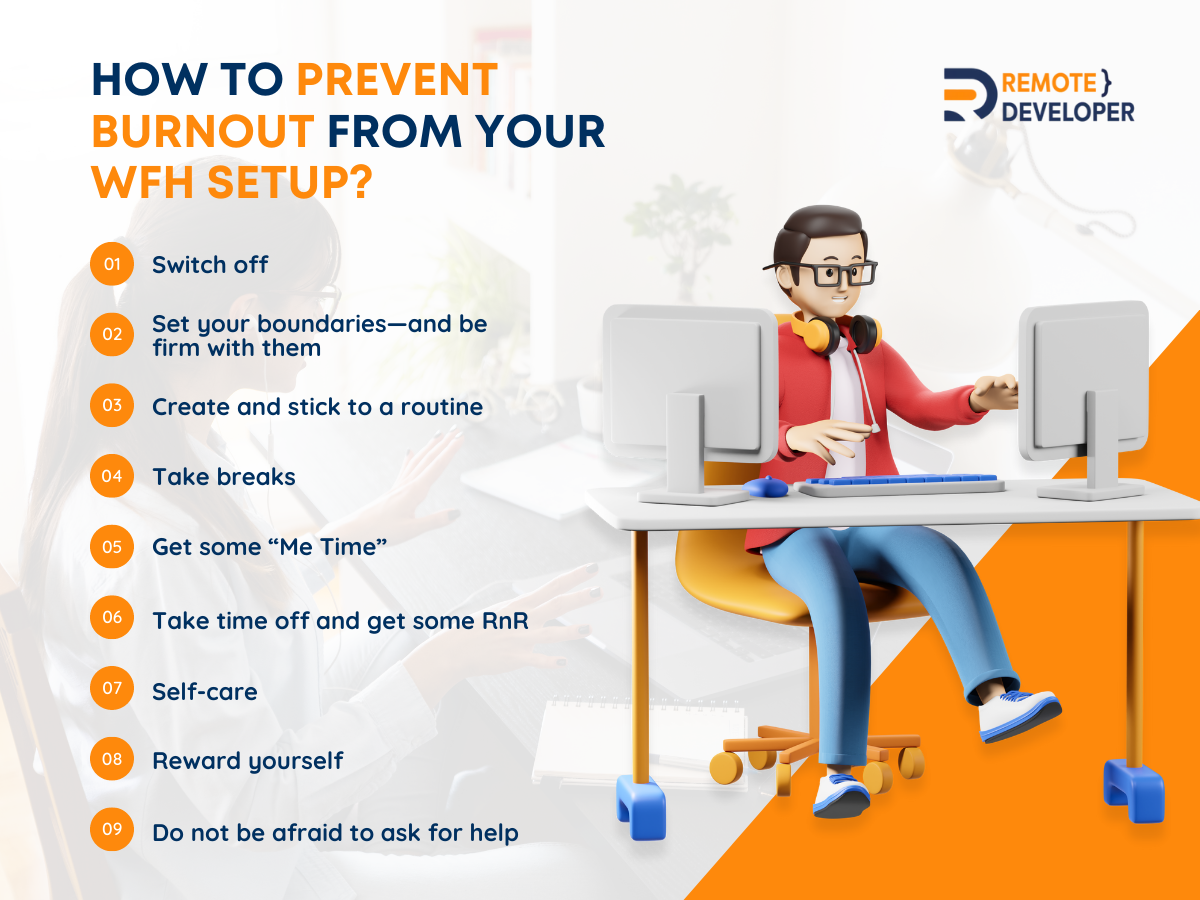In all honesty, the traditional office workplace setup was already a stressful environment. However, everything in our lives took a 180-degree shift when the pandemic hit. We all struggled to adapt to the new normal and work-from-home (WFH) setup. All these played a key role in people experiencing burnout.
Burnout is nothing new. A lot of us have experienced it at one point in our careers. However, burnout became more frequent and intense during the height of the pandemic.
In fact, according to the Global Workplace 2021 Report, up to 43% of people from over 100 countries around the world reported experiencing burnout back in 2020. That is a big jump from the report of 38% back in 2019.
Having said that, the remote workplace set up is here to stay. There is no denying that it provides plenty of perks and conveniences we cannot enjoy in a traditional workplace set up.
So, we put together this article for you to find a couple of strategies for small business owners that can help you and your team avoid getting burned out at a WFH set up.
What is burnout?
First of all, what exactly is burnout? Burnout is a work-related stress that impacts your sense of accomplishment and sense of self.
As a result, you feel so dissatisfied with where you are at the moment, and it triggers a physical, mental, and emotional response to your whole being.
Evidently, these can manifest in a lot of ways and impact your overall well-being. Here are a couple of symptoms that come with burnout:
- Physical symptoms like headaches, fatigue, heart palpitations, indigestion, and getting sick
- Decrease in productivity and efficiency
- Loss of motivation
- Difficulty focusing, disengagement, detachment
- Change in sleep routine or insomnia
- Feelings of irritability, frustration, or hopelessness
- Experiencing anxiety or depression
8 Major causes of burnout you need to watch out for
So, why do you experience burnout from your WFH set up? Here are some of the causes of burnout:
Challenging workloads
Having too much work on your team’s plate or people in your team passing off their tasks to other people can cause burnout. As more tasks are added, the amount of work might not match their present capacity. Likewise, it becomes harder to prioritise the actual essential tasks.
Lack of control
Instability at work usually stems from a lack of access to necessary resources to help them become effective. It can also be caused by frequent shifts of priorities that you and your managers set. Additionally, you might not have clarified their responsibilities and the scope of their work.

Limited or Zero rewards
Any form of reward encourages people to do better. However, in a workplace that gives little to zero rewards, it is no surprise that your team would experience burnout. Scarcity in rewards, whether these are prizes, awards, or even recognition of their contributions, may make them feel unappreciated.
Lack of community
Another cause for burnout is the lack of community. There is no denying that building a sense of community in a WFH set up is harder, especially when everything is done virtually. However, it can be done. But it is a lot harder if there are no efforts from you and other leaders in your company or even any support.
Unfair treatment
Do you know someone in your team who is always recognised for their efforts? Do you or other managers commend other people for their contributions?
If the answer is no, this can be because of unfair treatment. Any form of unjust inequality in the workplace undeniably affects the job performance and motivation of underappreciated employees—which naturally leads to burnout.
Toxic environment
According to O.C. Tanner’s 2020 Global Culture Report, a toxic work environment escalates moderate burnout to severe by 157%. To make matters worse, in a 2022 report from MIT Sloan Review, employees in toxic environments are 10.4 times more likely to quit as a result.
Unfair expectations
Unreasonable KPIs can be a source of constant worry about job performance. These can be expectations beyond the scope of the responsibilities of their position. Or, it can also be expectations that have not been identified properly by you or a manager.
Challenging leadership
Poor leadership can also be a cause of burnout. This can manifest in a lot of ways, like last-minute requests or projects that are due in a few hours or by the end of the day. It can also manifest through poor communication on their part to properly brief the team. As a result, the blame can be shifted onto the team for failing to deliver.
How to prevent burnout from your WFH setup?
Dealing with burnout sounds like a tall order to achieve, but it can be done.
In truth, it needs to be done. Constant struggle or burnout can usually impede the sustainable growth of your business in the long run. Having said that, here are a couple of things to avoid burnouts that you and your team can do right now:
Switch off
This is one of the easiest burnout prevention strategies for small businesses. Encourage your team to switch off their computers, laptops, and notifications once work is done. Make it clear to them that they do not have to answer calls or emails during breaks, lunch breaks, and especially after work.
Set your boundaries—and be firm with them
In a WFH set up, there is no clear distinction between work and home life. So you need to set that boundary yourself. Aside from switching off after work, there are a couple more things to set boundaries. Here are a couple of things you can remind your team to do right now:
- Tell your family when you cannot be disturbed or when you have a meeting
- Focusing on work during work hours only.
- Informing clients and teammates that you can be contacted within working hours.
Another thing is to remind them to be firm with their boundaries. It might seem rude but drawing a line between work and other things in their life is necessary for sustainable growth.
Create and stick to a routine
Another thing you can do for sustainable growth, in the long run, is to create a routine, before and after work. When motivation fails you, the structure and habits you created for yourself will be your saving grace when you feel burnt out.
A routine creates a sense of normality in your team’s everyday life. Plus, it takes less mental space and lessens any possible stressors that can further contribute to their burnout.
Lead by example. You can share your morning and evening routine and encourage your team to apply it in their WFH set up.
Take breaks
One of the easy-to-apply strategies for small business owners and teams to avoid burnout in a WFH set up is to remind each other to take breaks.
It can be just a simple walk to the refrigerator or chores that do not require a lot of their time, like laundry. The point is to encourage your employees to get up, rest their eyes, and shift their focus elsewhere for a brief moment.
“Me Time”
Carving out some downtime for yourself is an absolute must. It lets you get away from work and shifts the focus onto the things you need and want.
It can be a simple time for yourself to enjoy the things you love, such as your hobbies and favourite music, films, and food, to name a few. The point is to let you get in touch with yourself again and do something that makes you happy and satisfied.
Take time off and get some RnR
Taking time off and focusing on rest and recuperation (RnR) prevents burnout and encourages sustainable growth. One, they have something to look forward to that can become a form of self-reward and drive them to do better at work. Two, even a weekend-long getaway can help them recharge and take their mind off work.
One of the strategies for small business owners is to book a weekend getaway for the team as a form of team building or just a reward for the people who have performed well.
Self-care—physically, mentally, and emotionally
There are a lot of ways to practise self-care. It is not a one size fits all situation because the point is to help you heal, rest, and have sustainable growth over time.
Self-care can be just about focusing on the stuff that makes them happy. But it can also be the stuff they need to ensure they are physically, mentally, and emotionally healthy – such as exercise, incorporating nourishing food in their diet, getting enough sleep, and doing the work for mental and emotional health.
One of the strategies small business owners can apply for this is to set up talks with health advisors that can teach your team a couple of ways employees can help avoid burnout and to practise self-care even in a WFH set up.
Reward yourself
We all have things we like and want. You can use that as a way to motivate yourself to achieve your goals and reward yourself.
In the case of your team in a WFH set up, you can encourage them by starting small such as meeting a deadline, completing several tasks within a day, and acing their report or presentation. After that, you can reward them with an item they have been eyeing for a while now or a team lunch where you can bond.
The point of creating a reward system is to motivate and encourage them to look forward to something great outside of work.
Do not be afraid to ask for help
A WFH set up can feel very isolating. Unlike in a traditional workplace set up, your team does not have the luxury to be physically present and support each other. But that should not deter you from reminding them that they can always ask for help whenever they need it.
Furthermore, dealing with burnout does not have to be a solo journey. Here are a couple of things you can encourage them to do:
- Talk with you or their direct supervisor. Encourage them to share their struggles with their present workload or you can provide additional resources to make their work easier
- Talk with your teammates. Always check in with them on how they are doing in their WFH set up and encourage them to reach out when a certain task is confusing or difficult to do alone
- Talk to a healthcare professional. Sometimes seeking professional help will give them the direction they need. As a small business owner, you can make services like this more accessible to encourage them to seek the help they need to deal with burnout.
Help your team in any way you can
Burnout can happen to anyone, especially now that a lot of people are working in a WFH set up. It is evident that it is harder to separate and create the work-life balance we used to have in a traditional workplace.
But suffering through it should not be the case. A WFH setup provides opportunities and sustainable growth for your small business as well as for your team members when they are able to deal with burnout in a healthy way.
In truth, it will require a lot of effort for you and your team because it requires change. Not just in your work structure and strategy but also in your workplace culture. When done right, you will see your team thrive and increase company retention and performance.
Want to learn more? Visit our website to know more about starting your own business!

